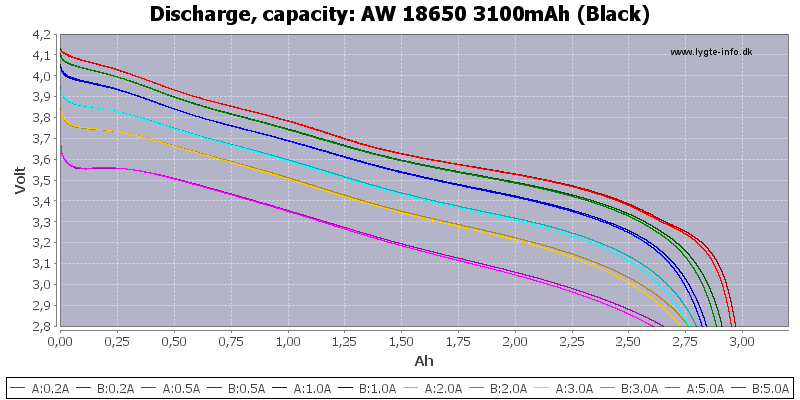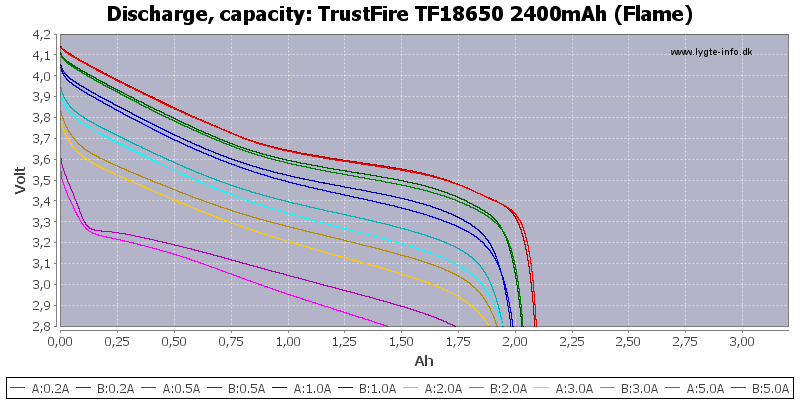I was thinking of getting 6 of these. Maybe not now…
2.57v now.
I've had to stop the test as I'm about to go to bed. It wouldn't be too wise continuing without keeping a close eye on this cell.
Tomorrow after work I will continue to see how low it will go before tripping (if it ever does!!).
I've never had to go this low before. But when it comes to conducting runtime tests it's essential to have a decent protected cell which will draw the line at ideally 2.7v. If not, it totally screws up the runtime graph! As other users will have a different expectation of the light, as most protected cells will trip at around 2.7v.
The 6 cells in question were purchased in March 2011 from an Ebay user. It might be difficult to track exactly whom.
I'm guessing all 6 most likely have this fault. But we shall see...
Please try to trip the low-voltage protection in HI mode, and see if that makes a difference.
I've experienced PCBs that would not trip the low-volt trigger unless a certain current draw was used. While 900Ma seems quite high for this threshold, this may be the issue.
I had a light with a fairly high standby (parasitic) current draw, due to the early electronic switch design. I was not aware of the high standby draw at the time, and when the light was put into use in an emergency situation, the cell was at 2.2V and toasted.
The P60 drop-in is struggling to get into HI mode at this moment in time with this cell, as there isn't significant power left in the cell. The modes are not cycling properly.
In a separate runtime test in HI mode with the same drop-in and with one of my Hi-Max cells I got down to 2.65v before I stopped the test. It's really not good!
I'm not saying that we all should rely on the protection to trip, but isn't this why we buy protected cells? To add a little layer of security.
It shouldn't matter how much current is being drawn from the cell, any protection circuit worth a damn should trip once the cell reaches a set voltage.
While I've heard of PCBs having trip levels as low as 2.4v, that seems pretty useless for our needs.
I definitely agree! Having a protection circuit which trips at 2.4v is absolutely pointless! It might as well be an unprotected cell as far as I'm concerned!
I'm whiling to ruin one of my Hi-Max cells tomorrow just to see how low the voltage of the cell will go until the protection trips!
That's the spirit.. ;-)
900 mAh was with full batteries, what is it pulling from the almost empty cell on mid?
Tenergy seems to make their PCB to trip at 2.5V
Just a suggestion. Maybe try a different charger? Sometimes a different charger can trip the circuit back into action.
You should never rely on the protection circuit to trip when discharging Li-ion cells, even if it does trip you are discharging your cells far too deeply if you expect to get the maximum life from your cells. There really isn't much capacity below about 3.3 Volts, all you're doing is shortening the life of your cells.
As a general rule that is wrong, the Panasonic 2900/3100 cells has a lot of capacity below 3.3 volt. At 5 ampere current draw it is more than half capacity.

Before I went to sleep last night I tested the cell voltage again.
It had risen from 2.60v to 2.80v
This morning after testing again (a cell rest of 8 hours) the cell voltage is 3.2v
Current draw on MID mode at 3.2v is 230mA
I agree that may be true for the Panasonics, but for the majority of cells I've tested the graph drops off quite steeply below 3.3V / 3.2V.
I just looked through some of your tests and they confirm the above statement. This one as an example http://budgetlightforum.com/comment/reply/7000?quote=1#comment-form
Did you charge it?
It is the only one that behave that way or all you have?
I agree that may be true for the Panasonics, but for the majority of cells I've tested the graph drops off quite steeply below 3.3V / 3.2V.
I just looked through some of your tests and they confirm the above statement. This one as an example http://budgetlightforum.com/comment/reply/7000?quote=1#comment-form
Many does, especially if you keep the load below 2A, but at higher load you need to discharge to a lower voltage.
Here from another TrustFire battery:
From my experience cell voltage under load has to drop to around 2.5V (or even lower) to trip protection circuit. After resetting protection circuit and removing load, cell voltage will be around 2.8 thus providing adequate protection to the cell. There is possibility that under (very) small load protection circuit might not work.
I kept the drop-in running tonight and finally the protection circuit tripped at 2.5V.
I'm in agreement with chiefinspectorfinch. Mine are set to trip at 2.5V, very low for my liking! It also totally screws up runtime tests. 
I know we can't trust the protection, but I'm thinking about if I hand out a single 18650 powered light to a non flashaholic that doesn't have a DMM (lol) = an over discharged cell which comes back to me, best case.
Did you measure cell voltage after resetting protection circuit ?
Voltage was 2.6V after it came out of protection.
It's good to test a cell down to it's limit like this, in a controlled way. I now know how to treat this cell.
Tripping at 2.5V is pretty terrible though, the protection circuit isn't a million miles away from being totally useless. Perhaps I should call this a semi-protected cell 
Think of a protection circuit as more of a seat belt for your cell something for emergencies (shorted cell for instance) not something you want to rely on in general use.
